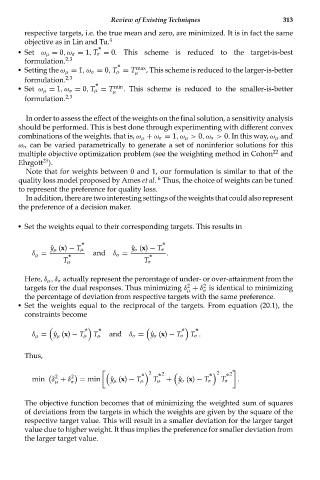Page 328 - Six Sigma Advanced Tools for Black Belts and Master Black Belts
P. 328
OTE/SPH
OTE/SPH
3:6
Char Count= 0
August 31, 2006
JWBK119-20
Review of Existing Techniques 313
respective targets, i.e. the true mean and zero, are minimized. It is in fact the same
objective as in Lin and Tu. 4
*
Set ω μ = 0,ω σ = 1, T σ = 0. This scheme is reduced to the target-is-best
formulation. 2,3
* max
Setting the ω μ = 1,ω σ = 0, T μ = T μ
, This scheme is reduced to the larger-is-better
formulation. 2,3
* min
Set ω μ = 1,ω σ = 0, T μ = T . This scheme is reduced to the smaller-is-better
μ
formulation. 2,3
In order to assess the effect of the weights on the final solution, a sensitivity analysis
should be performed. This is best done through experimenting with different convex
combinations of the weights, that is, ω μ + ω σ = 1,ω μ > 0,ω σ > 0. In this way, ω μ and
ω σ can be varied parametrically to generate a set of noninferior solutions for this
multiple objective optimization problem (see the weighting method in Cohon 22 and
23
Ehrgott ).
Note that for weights between 0 and 1, our formulation is similar to that of the
6
quality loss model proposed by Ames et al. Thus, the choice of weights can be tuned
to represent the preference for quality loss.
In addition, there are two interesting settings of the weights that could also represent
the preference of a decision maker.
Set the weights equal to their corresponding targets. This results in
* *
ˆ y μ (x) − T μ ˆ y σ (x) − T σ
δ μ = and δ σ = .
* *
T μ T σ
Here, δ μ ,δ σ actually represent the percentage of under- or over-attainment from the
2
2
targets for the dual responses. Thus minimizing δ + δ is identical to minimizing
σ
μ
the percentage of deviation from respective targets with the same preference.
Set the weights equal to the reciprocal of the targets. From equation (20.1), the
constraints become
* * * *
δ μ = ˆy μ (x) − T μ T μ and δ σ = ˆy σ (x) − T σ T σ .
Thus,
2 2 2 2
2 2 * * * *
min δ + δ σ = min ˆ y μ (x) − T μ T μ + ˆy σ (x) − T σ T σ .
μ
The objective function becomes that of minimizing the weighted sum of squares
of deviations from the targets in which the weights are given by the square of the
respective target value. This will result in a smaller deviation for the larger target
value due to higher weight. It thus implies the preference for smaller deviation from
the larger target value.

